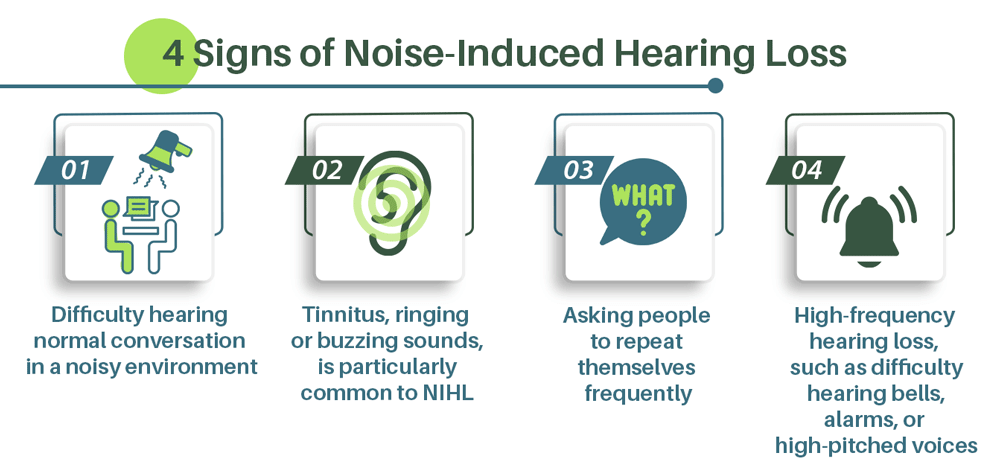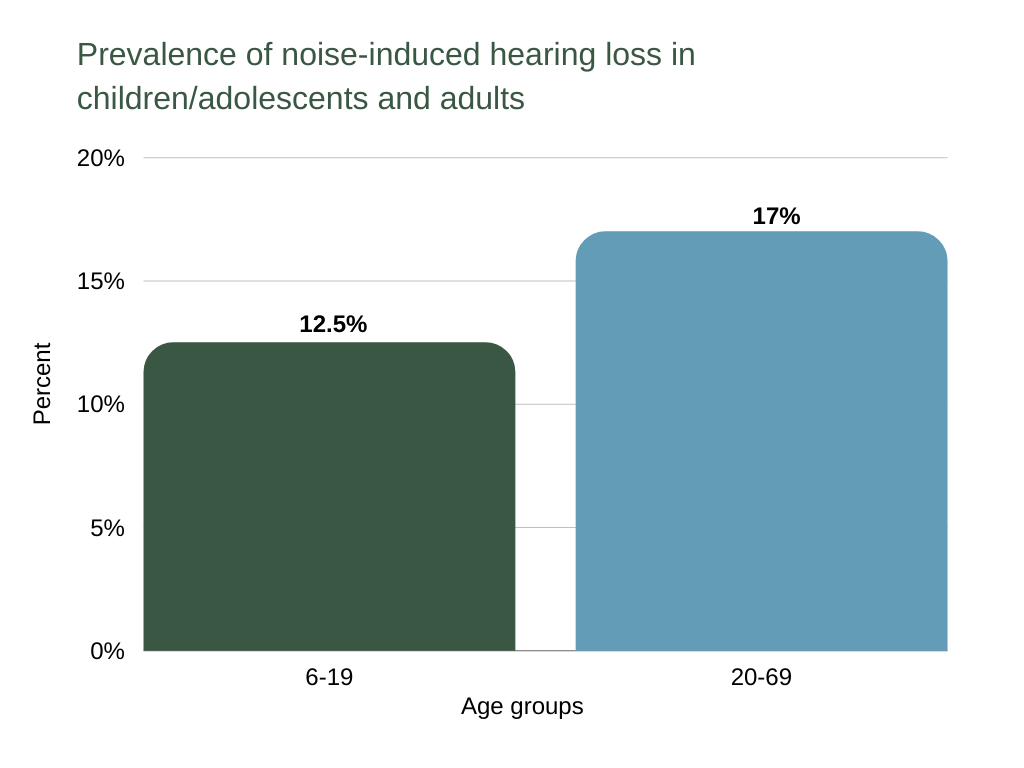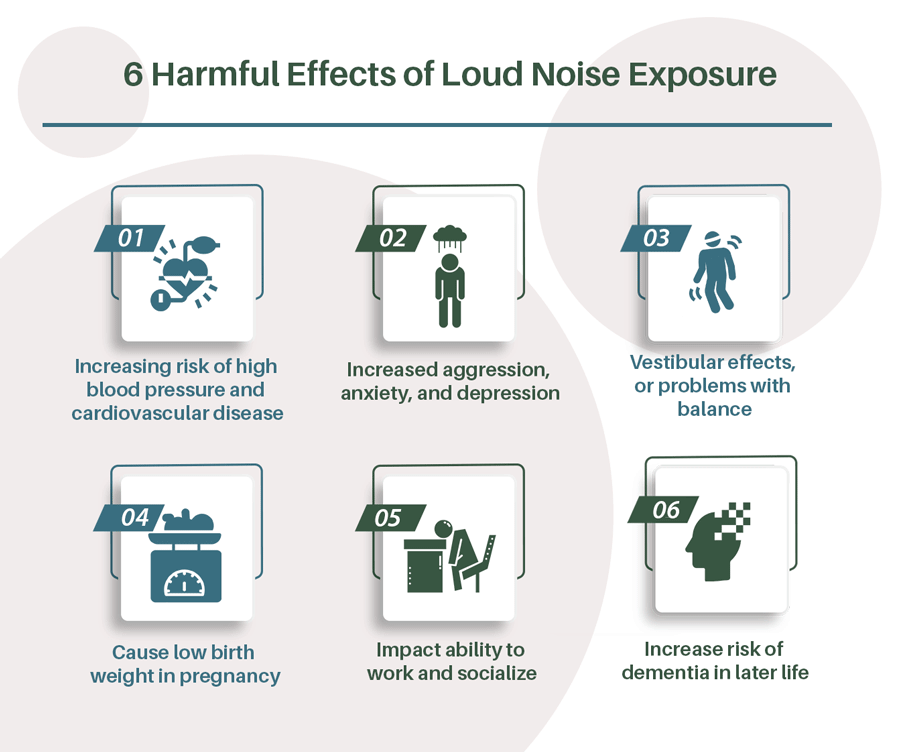Everyone has had some variation on the same experience. You leave a loud club, concert, factory floor, or worksite, and suddenly everything sounds a little muffled. There might be an irritating little ringing in the distance as well. If that sounds at all familiar, then you have sustained noise-induced hearing loss.
Most of the time, your hearing will return without a problem. You have to wonder, though, at what point does that hearing loss become permanent?
Key Takeaways: Noise-Induced Hearing Loss
- Noise-induced hearing loss is the number one cause of preventable hearing loss.
- When damage occurs to the hair cells in the inner ear, it can lead to temporary or permanent hearing loss.
- The first sign is usually a ‘notch’ in the hearing range, meaning there is hearing loss in a particular band of frequencies.
- Tinnitus, or ringing in the ears, is also a common symptom of noise-induced hearing loss.
- Hearing loss can be temporary, returning to normal after a day or two. Repeated noise exposure can make it permanent.
- Occupational noise is often associated with noise-induced hearing loss. Loud music is another common cause.
- At the moment noise-induced hearing loss isn’t reversible, though there are always new treatments under investigation.
What Is Noise-Induced Hearing Loss?
Noise-induced hearing loss (NIHL) is a decrease in hearing sensitivity, due to damage caused by loud noise. One of the most common causes is occupational hearing loss, as the result of working somewhere loud. There is also concern regarding recreational sound, including loud music.
It can be a temporary hearing loss, though repeated exposure can quickly make it permanent. You can have trouble hearing in one ear or both, but usually, both sides are affected equally.
There are several types of hearing loss, depending on what part of the human ear is damaged. Noise-induced hearing loss is usually caused by damage to the inner ear, specifically the nerve cells there.
What Causes NIHL?
As we’ve mentioned, noise-induced hearing loss is the result of damage to the inner ear, technically called sensorineural hearing loss. The outer ear, ear canal, and middle ear are all fairly hardy and resistant to damage. The hair cells and nerves within the inner ear, on the other hand, are delicate enough that they can be damaged by a very loud noise.
We don’t often realize it, but sound actually has force and substance. It consists of vibrations moving through the air. When noise levels are high enough, they can blow back our hair or make our chests vibrate. If something fragile like nerve cells get in the way of that force, they can be vibrated to pieces.
Additionally, it’s not just the noise levels, but also its duration. Continuous noise hazards can lead to gradual hearing loss. Sometimes hearing will recover, particularly when the sound is limited, such as after attending loud concerts or hearing a single loud blast. If the sound is intense enough or goes on too long, however, you may have suffered permanent damage [1].
Signs of Noise-Induced Hearing Loss
Some signs of hearing loss can have a range of causes, including noise-induced hearing loss. Among those are:

- Difficulty hearing normal conversation in a noisy environment.
- Tinnitus, ringing or buzzing sounds, is particularly common to NIHL.
- Asking people to repeat themselves frequently.
- High-frequency hearing loss, such as difficulty hearing bells, alarms, or high-pitched voices.
With noise-induced hearing loss, the high-frequency hearing loss usually occurs in a notch. In other words, hearing is impaired in a specific frequency band, but unaffected at higher and lower frequencies [2].
Additionally, you may experience a temporary threshold shift, in which hearing is lost but then regained later. If damaged too frequently, it can become a permanent threshold shift, in which hearing is not regained.
Who Is Affected?
The incidence of noise-induced hearing loss is on the rise globally, as more and more people are affected. Traditionally, it was a problem associated with your workplace. Examples of careers at risk for noise-induced hearing loss include:
- Musicians.
- Construction workers.
- Military service people.
- Factory workers.
Many people might be exposed to a repeated loud noise at their job, or work in noisy environments for an extended period. In fact, one-third of adults in noisy work environments have trouble hearing [3].
A newer concern is the damage done to young adults’ hearing due to unsafe practices. Attending loud concerts can have an effect. However, it’s headphones and personal music that may present a greater danger [4]. The resulting damage to the inner ear can have consequences later in life.

Source: https://www.cdc.gov/ncbddd/hearingloss/noise.html
Noise-Induced Hearing Loss Statistics
Exposure to loud noises is the primary cause of preventable hearing loss. Of the total US workforce, 25% are exposed to occupational noise. Approximately 33% of them have some degree of hearing loss. In 16% of cases, the loss is enough to affect daily living [5].
Additionally, NIHL is considered one of the three most common conditions that can cause disability. The US Department of Veteran Affairs paid over one billion dollars in hearing loss compensation in 2012. The total economic impact is difficult to estimate.
Focusing on recreational noise, studies have found that as much as half the younger population listens to music loud enough to damage their hearing [6]. Other recreational causes of noise-induced hearing loss include:
- Firearms.
- Motorcycles/loud engines.
- Power-tools.
How Does Noise Damage Hearing?
The inner ear is largely composed of vibration-sensing hair cells. Those cells connect to the auditory or hearing nerve, which transmits the electrical signals the hair cells produce. These cells are quite delicate, such that a one-time exposure to loud noises can damage them, leading to temporary hearing loss.
The cells can cease to function entirely with repeated exposure or excessive noise exposure. At that point, hearing loss is permanent. A single, loud noise exposure can also cause permanent loss if the sound energy is great enough.
Sound vs Noise
Sound is everything that you hear. Noise is intrusive or unwanted sounds [7]. Noise pollution is the level of disturbing sound, for example. Interestingly, loud noises may be worse for your hearing than loud sounds, even at the same sound intensity. In other words, loud music may be slightly less damaging than the jackhammer outside your window.
The reason for the difference isn’t clear. Additionally, noise can lead people to start wearing ear protection, while a good song usually gets turned up. Ultimately, either source can cause hearing loss.
Harmful Effects of Loud Noise Exposure
When assessing the effects of excessively loud noise, it’s natural to suggest hearing loss as the first concern. However, while hearing damage may be the most obvious effect of loud noises, it’s not the only one. That damage can have consequences of its own, as hearing disorders can commonly lead to other communication disorders.
Additionally, as the Occupational Safety and Health Administration (OSHA) notes other effects are possible. Loud noise may also have effects like:

- Increasing risk of high blood pressure and cardiovascular disease.
- Increased aggression, anxiety, and depression.
- Vestibular effects, or problems with balance.
- Cause low birth weight in pregnancy.
- Impact ability to work and socialize.
- Increase risk of dementia in later life.
Loud noise has also been found to disrupt DNA within the cells of animals [8][9].
Long Terms Effects of NIHL
The effects of noise-induced hearing loss are much more profound than simply having a harder time hearing the TV. Not being able to hear means a difficulty participating in the life surrounding you. As a result, an increase in stress and depression is not unusual.
Practical disadvantages include a challenge in finding jobs and a higher risk of further work-related injuries. As a result, the effects of hearing loss can be compounded by additional challenges.
Moreover, hearing loss is associated with a greater degree of cognitive decline earlier in life. Additionally, memory and attention span were also negatively affected.
As a result, avoiding noise-induced hearing loss is probably a good idea. However, there are some treatment options that can help.
How To Prevent Noise-Induced Hearing Loss
The most obvious strategy for reducing noise-induced hearing loss, avoiding harmful noise, is probably the best one. The specific limit usually cited is an average of 75 decibels over 8 hours, or 70 decibels over 24 hours [10].
In more practical terms, limit your noise exposure like blaring music and noisy places. Occupational safety is also critical. If you work around harmful noises, wear earplugs or other hearing protection devices. Investigate the hearing conservation program available at your job.
Any sort of excessive noise exposure, even background noise, can have an effect. As a result, it’s wise to get a regular hearing test to check for healthy hearing.
How To Treat Noise-Induced Hearing Loss
Some degree of noise-induced hearing loss in some professions may be inevitable. As a result, it’s natural to ask, “can hearing loss be reversed?” Unfortunately, in most cases, the answer is no. There are options like sound therapy that can help to some degree.
As we’ve mentioned, however, it’s usually sensorineural hearing loss. That involves the death of nerve and hair cells, neither of which can be replaced naturally. In most cases, the best option is relying on hearing protection.
Additionally, permanent hearing loss does have some treatment options. Hearing aids are common and becoming more advanced. Options like MDHearingAid’s Volt+ use digital noise-canceling technology, for example.
Reluctance is natural. However, treatment can make a real difference. We discussed some of the consequences of hearing loss, including decreased mood and disability.
However, using an aid, cochlear implant, or similar device can help reverse those effects a great deal. Using them helps reconnect you with others and retain hearing health [11].
Is It Curable?
At this point, NIHL results in permanent hearing loss. However, science continues to investigate options for addressing noise-induced hearing loss. Most lines of inquiry address replacing or regrowing the hair and nerve cells that are damaged.
Research on NIHL
At this point, we’re unable to repair or replace damaged hair cells and nerve cells. As a result, the hearing loss noise exposure causes is currently irreversible. However, there are a number of different experimental treatments being researched that one day may cure noise-induced hearing loss.
Lines of inquiry include:
- Steroids: Corticosteroids are already an established treatment for hearing protection.
- Protein treatment: Proteins like N-acetyl cysteine or some neurotrophins could theoretically encourage new cell growth.
- Gene-based therapy: Including stem-cell therapy, this could be another route to regrowing damaged cells.
- Nanoparticles: Using microscopic bubbles to deliver drugs directly to the affected area [12].
All of those strategies are still being studied and have yet to be tried on humans. Unfortunately, that means we are likely quite far from seeing the resulting treatments offered at your local audiologist’s office [13].
What To Do When You Suspect Noise-Induced Hearing Loss
The first signs can vary. You may suddenly find yourself needing closed captioning to follow TV shows. Perhaps you can’t hear the doorbell anymore and everyone has suddenly started to mumble. When that happens, it’s time to consider the possibility of hearing loss.
Noise-induced hearing loss may present as sudden hearing loss or it may be more gradual. In either case, the first step is to get your hearing tested. It might be a good idea to start with one of the best online hearing tests, which can tell you if you should be worried. That should eventually lead to a hearing test with an audiologist.
Additionally, it becomes more important to retain what you have. Turning down the volume and using hearing protection is a good idea.
Is a Hearing Aid Necessary?
While it can depend on the degree of hearing loss, hearing aids may not be a bad idea. They can’t replace your lost hearing, but they can make your life easier. They work by increasing the volume in the specific bands you’ve lost hearing, ideally so that everything is a consistent volume.
Some options, like the MDHearingAid Volt+ also add noise cancelation functions, or can connect with your phone via Bluetooth. You may only need an aid for one ear, or both. Note that they don’t double as hearing protectors, so it might also be wise to invest in some earmuffs.
Other options include a cochlear implant or bone-anchored hearing aid (BAHA). These also amplify sound electronically to make it easier to hear. The cochlear implant transmits sound to the auditory nerve, while the BAHA transmits vibrations to the cochlea. Both of those have a greater positive effect on quality of life after hearing loss.
FAQ
Check out these quick answers to basic questions.
Can You Recover From NIHL?
There is a limited ability to treat hearing loss, at the moment. Noise-induced hearing loss usually involves damage to the nerve endings in your ear, which can’t be undone. As a result, it’s not possible to recover from permanent noise-induced hearing loss.
In some cases after a loud sound exposure, hearing returns to normal. However, another such exposure could make it permanent. At that point, it’s a good idea to take a hearing test and begin wearing hearing protection.
How Long Does It Take To Develop Noise Induced Hearing Loss?
There are many variables that affect the answer to this question. One of the most important is the intensity of the sound. Hearing loss will be more gradual when you’re exposed to loud sounds continuously at your job. On the other hand, a single, very intense noise can cause hearing loss in one burst.
Most often, noise-induced hearing loss begins with a ‘notch’ in your hearing, a band of frequencies to which you’re not as sensitive. That notch is usually in higher frequency, or higher tone, sounds. Noise-induced hearing loss is also often accompanied by tinnitus.
What Is the Most Common Cause of Noise Induced Hearing Loss?
In one sense, the cause of noise-induced hearing loss is always the same. Intense sound has damaged the hair cells within the inner ear. As a result, they no longer transmit electrical signals to the brain, resulting in hearing loss.
The most common cause of that damage is exposure to very intense noise. It may be consistent over time, as at your workplace. Music played extremely loudly also seems to be emerging as a common cause of noise-induced hearing loss.
Conclusion
No one wants to stop and worry about hearing health in the middle of a good tune. When you’re at work, you have other priorities than keeping track of a pair of earplugs. On the other hand, the song will end and before too long you’ll probably move on to another job. However, the consequences to your hearing may be with you forever.
It may not seem like a big deal in the moment, but noise-induced hearing loss can affect your life in significant ways. You don’t want to start smoking because of the long-term consequences to your health. Protecting your hearing may be just as important.
References:
- Le, Trung N., et al. “Current Insights in Noise-Induced Hearing Loss: A Literature Review of the Underlying Mechanism, Pathophysiology, Asymmetry, and Management Options.” Journal of Otolaryngology – Head & Neck Surgery, BioMed Central, 23 May 2017, https://journalotohns.biomedcentral.com/articles/10.1186/s40463-017-0219-x.
- Mirza, Raul, et al. “Occupational Noise-Induced Hearing Loss : Journal of Occupational and Environmental Medicine.” LWW, Sept. 2019, https://journals.lww.com/joem/Fulltext/2018/09000/Occupational_Noise_Induced_Hearing_Loss.24.aspx.
- Carroll YI, Eichwald J, Scinicariello F, et al. Vital Signs: Noise-Induced Hearing Loss Among Adults — United States 2011–2012. MMWR Morb Mortal Wkly Rep 2017;66:139–144. DOI: http://dx.doi.org/10.15585/mmwr.mm6605e3
- Neitzel, Richard L., and Brian J. Fligor. “Risk of Noise-Induced Hearing Loss Due to Recreational Sound: Review and Recommendations.” Scitation, Acoustical Society of America ASA, 27 Nov. 2019, https://asa.scitation.org/doi/full/10.1121/1.5132287.
- Themann, Christa L., and Elizabeth A. Masterson. “Occupational Noise Exposure: A Review of Its Effects, Epidemiology, and Impact with Recommendations for Reducing Its Burden.” Scitation, Acoustical Society of America ASA, 27 Nov. 2019, https://asa.scitation.org/doi/full/10.1121/1.5134465.
- Make Listening Safe Make Listening Safe – Who. https://www.who.int/pbd/deafness/activities/MLS_Brochure_English_lowres_for_web.pdf.
- Casali, John G. “Sound and Noise: Measurement and Design Guidance.” Wiley Online Library, John Wiley & Sons, Ltd, 13 Aug. 2021, https://onlinelibrary.wiley.com/doi/abs/10.1002/9781119636113.ch18.
- Alimohammadi, Iraj, et al. “Effect of Chronic Noise Exposure on Aggressive Behavior of Automotive Industry Workers.” The International Journal of Occupational and Environmental Medicine, Shiraz: NIOC Health Organization, Oct. 2018, https://www.ncbi.nlm.nih.gov/pmc/articles/PMC6466992/.
- Frenzilli, Giada, et al. “Loud Noise Exposure Produces DNA, Neurotransmitter and Morphological Damage within Specific Brain Areas.” Frontiers, Frontiers, 26 June 2017, https://www.frontiersin.org/articles/10.3389/fnana.2017.00049/full.
- “What Noises Cause Hearing Loss?” Centers for Disease Control and Prevention, Centers for Disease Control and Prevention, 7 Oct. 2019, https://www.cdc.gov/nceh/hearing_loss/what_noises_cause_hearing_loss.html.
- Brodie, Arjuna, et al. “The Impact of Rehabilitation on Quality of Life after Hearing Loss: A Systematic Review.” European Archives of Oto-Rhino-Laryngology, Springer Berlin Heidelberg, 23 Aug. 2018, https://link.springer.com/article/10.1007/s00405-018-5100-7#Sec5.
- Kayyali, Mohammad N., et al. “A Novel Nanoparticle Delivery System for Targeted Therapy of Noise-Induced Hearing Loss.” Journal of Controlled Release, Elsevier, 16 Apr. 2018, https://www.sciencedirect.com/science/article/abs/pii/S0168365918302116.
- Eshraghi, Adrien A., et al. “Recent Advancements in Gene and Stem Cell‐Based Treatment Modalities: Potential Implications in Noise‐Induced Hearing Loss.” American Association for Anatomy, John Wiley & Sons, Ltd, 25 Mar. 2019, https://anatomypubs.onlinelibrary.wiley.com/doi/full/10.1002/ar.24107.





Leave a Reply